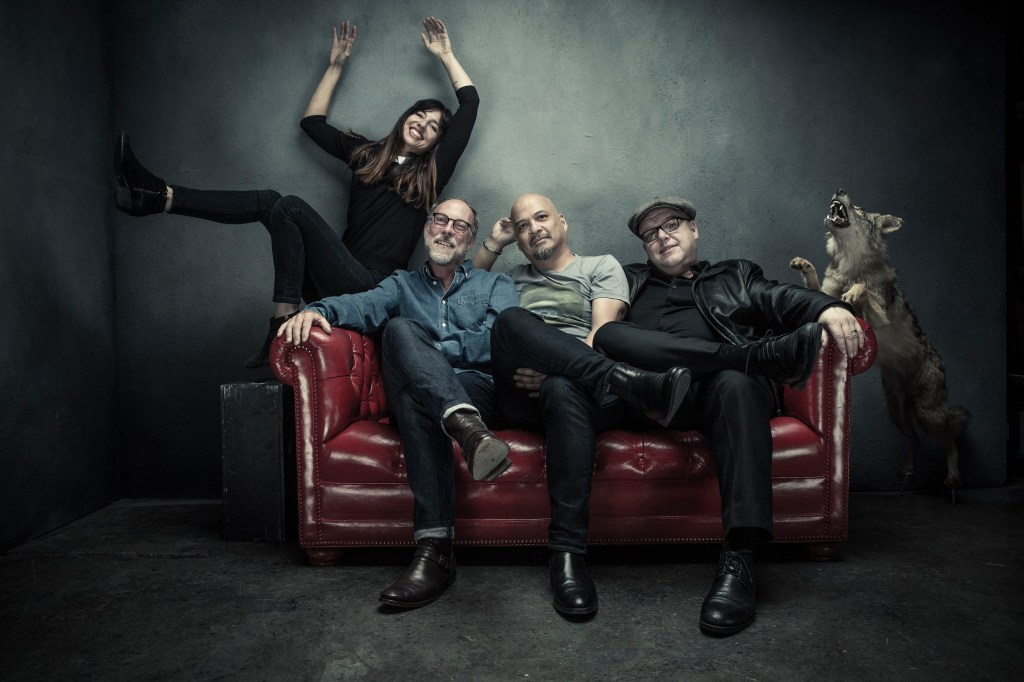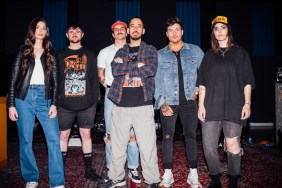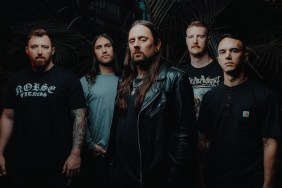If you’ve ever been drawn to guitar music that wanders from conventional straightforwardness and down a more angular, peculiar path, then you’re indebted in one way or another to the Pixies. There’s no minimising the legacy of these indie-rock icons – through classic albums such as Doolittle and Surfer Rosa, as well as world-renown anthems like Where is My Mind? and Debaser, the band’s shadow is still cast long and looming over the spectrum of contemporary rock music. They have served generation after generation of fans, from those that were yelling along through their college years back in the ’80s to the kids that discovered them through that scene in the movie adaptation of Fight Club.
After years of nostalgia touring, two major shake-ups came a matter of years ago within quick succession of one another. The first was the departure of Kim Deal, the band’s bassist and one of its two vocalists; marking the first time in the band’s history that anyone had left the group. If that wasn’t enough to upset the more conservative side of the Pixies fan-base, it was followed with the announcement that new material was coming from the band. The comments section, naturally, flared up; with each throwing around the pun-laden phrase “NO KIM = NO DEAL,” as if they were the first to come up with it. Still, the band persevered – and, several years on, the facts speak for themselves. The band still count themselves as one of the most in-demand touring acts around, and not even those that were naysaying their recorded output could deny the band in the live arena.
In 2016, the Pixies are looking to prove their staying power. They have a brand-new album in tow, entitled Head Carrier; as well as a cemented line-up thanks to bassist/vocalist/violinist Paz Lenchantin, whom you may know from her time in bands such as A Perfect Circle and Zwan. They’re also heading out on tour, which will bring them back to Australia in March of 2017 for a run of massive shows. If Head Carrier is anything to go by, there’s still life after Deal – and it’s worth celebrating with them.
In a rare interview, Music Feeds spoke with the band’s figurehead – singer and guitarist Charles Michale Kittridge Thompson IV, otherwise known as Black Francis. Ahead of Head Carrier‘s worldwide release, Francis opens up about changing the lineup, taking risks and becoming cool again in your 40s.
Music Feeds: Let’s begin by talking about the trajectory of the band – specifically, the two separate phases of its existence. The initial Pixies reunion shows took place in 2004, and the band has been active ever since. At 12 years, that is officially five years longer than how long the Pixies lasted in the first place. When you originally reformed the band, did you have any idea that you’d still be active in every sense over a decade after the fact?
Black Francis: No, we didn’t really think about it. I guess there might have been an assumption, initially, that we would tour for about a year or so. When it extended, we didn’t think about it one way or another – it was just more shows. It wasn’t up for analysis. It wasn’t much more remarkable than that – I mean, we were definitely happy that people still wanted us to come and play shows. It wasn’t much of a conversation piece. Ultimately, we just accepted it. It was like a coronation – we were crowned as ‘cool’ and ‘relevant’ again, even though we hadn’t put out a record in a long time and we were a lot older than a lot of our peers and the bands that we were playing with. We just went with it – it’s like, “Okay, the Pixies are cool now!” [laughs]
MF: You mentioned not putting a record out – aside from one single, Bam Thwok, we didn’t hear any new Pixies material until about 2013 with the single Bagboy, which ended up being a part of 2014’s Indie Cindy. At what point did the impetus to start creating again factor into the band’s routine – especially considering the band was quite comfortable simply playing the older material for quite some time?
BF: I think the impulse was always there – with myself, at least. It might have been the case with some other band members, too – but let’s just say that we weren’t all in agreement at any given time. It took a long time for it to actually happen. There was a period, maybe about seven or eight years ago, that we started to record a couple of things. It was mostly just myself, with Joey [Santiago, lead guitar] and David [Lovering, drums] adding bits in as well – so the idea of making another record was kicking around for quite a long time. The thing stopping it was a group consensus. Ultimately, I think that was part of the conflict with Kim – she didn’t want to do it all again, and that was fine. It wasn’t like we fought about it or anything like that. Out of respect to her reticence, we held off making a record.
Finally, the day came where she came to us and said, “Alright, I’ll do it.” We began recording, and then she was gone. I still don’t know why she left – it just happened. What’s there to say about that? It doesn’t help the situation any way to convince her otherwise.
MF: Paz toured with the band for about two years before she was officially inducted into the band as Kim’s full-time replacement. How did you come across her initially?
BF: Her reputation preceded her – a lot of people that we were talking to in Los Angeles immediately brought her up when we were looking to fill out the lineup again. So many people were just insisting – “You must give Paz a try, you should really consider working with her.” She ended up auditioning with us, along with a couple of other bass players. She actually worked with Joey on another [project] a few years before that, too. When we first rehearsed with her, there were two or three others that auditioned. They were all great, and were all perfectly suitable for being in our band. We didn’t pick Paz, and that was mostly down to me. I went with Kim [Shattuck], because I thought it was going to be the right call for the band. We toured for a few months, and that didn’t work out. Joey and David were both insisting, “It’s Paz – it has to be Paz.” Six months later, I was throwing my hands up and saying, “Okay! You were right!” [laughs] “Let’s see if she’s still available.” Thankfully, she was.
MF: Was it always in the back of your head that Paz would end up with the Pixies on a full-time basis? She certainly makes her presence felt on Head Carrier, especially considering she has her first-ever lead vocal on one of its tracks.
BF: Yeah. I think I knew from the very first show that we played together. We already had an idea of what she was like to work with in the studio, as well – there was a song that we recorded that featured her on it that was an outtake from the Indie Cindy sessions, and we ended up putting it out as a part of the deluxe vinyl version of the record. From that, as well as the touring, the consensus within the band was pretty clear – she was the one.
MF: Let’s talk about the creative process of Head Carrier. What was the mindset going into making this record? Did you have any loftier ambitions circulating around its writing? Perhaps wanting to do something that you hadn’t tried on recordings previously?
BF: In the Pixies, there’s always been a kind of understanding that whatever new song we’ve got on deck has no rules attached to it. Whether we’re recording, rehearsing or just writing songs, there’s never been any set guidelines or regulations. I think of songs on our older records that are completely left of centre – you can look at the tracklisting of a record and point out that this song and this song have similarities, but then you’ll go a track or two later and think, “Oh, but what about this song? That’s an oddball.”
I think that we’ve always been open to experimentation, and to songs that don’t quite “fit,” per se. If we’re not bored by it, we’re pretty open to it. That’s always been a part of who we are – we’ve never tried to be a singular band. We have enough singular things in our own personalities and in the way that we play. We’re not worried about sticking to a certain style. We don’t mind doing a song that’s silly, or something that we’ve not done before. Sometimes, new ideas don’t always work out – but there’s no rhyme or reason as to why that might be. It’s hard to predict what will and won’t work – all we can do is give it a try.
https://youtu.be/6nrrDbpKR5A
MF: In the quote-unquote ‘heyday’ of the band, the Pixies were notorious for absolutely hating making music videos – to the point where, when they were made, they were done with a very knowing wink of being a contractual obligation. This, inadvertently, resulted in some cult-classic videos – ‘Here Comes Your Man’ features faux lip-syncing by simply opening your mouth when the vocals happen; while Velouria is footage of the band running down through a quarry in super-slow motion. There have been several really interesting clips made for the band in recent years – including the animated ‘Tenement Song’ just from a month or so ago. Have you softened your stance on music videos given you don’t necessarily have to be in them?
BF: When we first started making videos, it was blowing up into this over-expensive thing. It was an industry unto itself. There was all this label pressure to get into rotation on MTV, and there were all of these ridiculously-high production standards as well. It had become like big-budget film-making, really. I think that it was something that was easy to rebel against. I think, nowadays, the pressure no longer exists on videos. There’s no real need to spend a huge budget on making a video – especially, given the fast pace of something like the internet, these things can pass by without anyone really seeing it anyway. You just throw a couple of ideas around – or you hire someone to throw a couple of ideas around – and you just hope for the best. I don’t know… I guess, back in the day, I never really “believed” in the music video, so to speak. I’m not against them – I just don’t sit around watching them. I honestly wish I could get a little more involved, but it’s just a matter of having the time and the money to commit to it.
MF: Touring for Head Carrier is already underway ahead of the album’s official release, and it will see the band returning to Australia in March of 2017. It will be two-and-a-half years removed from your last time in Sydney, as well as a return to both Melbourne and Brisbane for the first time in seven. You’ve spent a lot of time in Australia, both with the Pixies and performing as Frank Black over the years. How would you describe your relationship with the country?
BF: You’re definitely right – I guess I have spent quite a bit of time there. I like the way the food tastes there – I don’t know what’s going on down there, but you do your food so well. A tomato tastes good, a pot of beans tastes good, a cup of coffee tastes good. It might be something in the soil – everything just tastes so great. The last time we were in Australia, we played for four nights at the Sydney Opera House. That was a really huge deal for us – it was like performing at Carnegie Hall or somewhere like that; a truly iconic venue. It was an honour not only to play there, but to perform there on multiple nights. We’re very proud of that. We enjoy playing there a lot – you all seem to be really up for it. I love hanging out in Perth, I love Melbourne, I have great memories of staring out at the ocean in Adelaide… there’s a lot of great memories in that place.
–
‘Head Carrier’ is out this Friday September 30th. Pixies will return to Australia in March 2017, touring in support of the new album. See dates and details below.
Pixies 2017 Australian Tour Dates
Tickets on sale now
Thursday, 2nd March
Riverstage, Brisbane
Tickets: Live Nation
Saturday, 4th March
Margaret Court Arena, Melbourne
Tickets: Live Nation
Tuesday, 7th March
Hordern Pavilion, Sydney
Tickets: Live Nation












